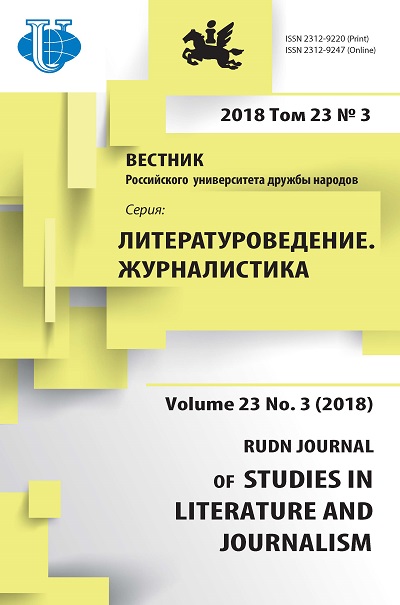«ОЧАЯННЫЕ РОМАНТИКИ»: ЭВОЛЮЦИЯ МИФА ОБ АИДЕ И ПЕРСЕФОНЕ ОТ ГРЕКОВ К ПРЕРАФАЭЛИТАМ И А. БЕЛОМУ
- Авторы: Кононова Н.О.1, Темиршина О.Р.1
-
Учреждения:
- Институт международного права и экономики им. А.С. Грибоедова
- Выпуск: Том 23, № 3 (2018)
- Страницы: 255-266
- Раздел: Литературоведение
- URL: https://journals.rudn.ru/literary-criticism/article/view/19014
- DOI: https://doi.org/10.22363/2312-9220-2018-23-3-255-266
- ID: 19014
Цитировать
Полный текст
Аннотация
Миф об Аиде и Персефоне рассматривается в статье как ключевой архетипический паттерн, по определению Юнга - «структурная предпосылка образов», к которым обращались художники и писатели разных эпох. Объектами исследования стали Гомеров гимн «К Деметре», «Метаморфозы» Овидия и повесть «Крещеный китаец» А. Белого, дополнительно изучены полотна представителей эпохи Ренессанса и прерафаэлитов, а также работа К.Г. Юнга «Душа и миф». Использованы сравнительно-сопоставительный, мифопоэтический, психологический методы и метод языкового анализа. В тексте исследуются мотивы и образы, формирующие архетипы Аида и Персефоны. Среди них - предельная противоречивость бинарной пары, требующая звена-медиатора для снятия конфликта. В мифе в качестве подобного звена используется образ гранатового зерна, у А. Белого роль медиатора выполняет биографический и символический ребенок. В повести «Крещеный китаец» художественным воплощением архетипа Аида выступает Михаил Летаев, черты Персефоны проявляются в матери Котика. В ходе исследования проведены параллели мотивно-образного порядка, выявлены сюжетные, цветовые и языковые аллюзии на мифологический сюжет. Неомиф об Аиде и Персефоне становится архетипическим маркером «отчаянного символизма» Белого, выразителем его желания преступить черту между инобытием и реальностью, словом и символом.
Ключевые слова
Об авторах
Наталия Олеговна Кононова
Институт международного права и экономики им. А.С. Грибоедова
Автор, ответственный за переписку.
Email: nataliyaolkon@mail.ru
аспирант кафедры истории журналистики и литературы Института международного права и экономики им. А.С. Грибоедова
Российская Федерация, 111024, Москва, шоссе Энтузиастов, 21Олеся Равильевна Темиршина
Институт международного права и экономики им. А.С. Грибоедова
Email: olesja@temirshina.ru
доктор филолологических наук, профессор кафедры истории журналистики и литературы Института международного права и экономики им. А.С. Грибоедова
Российская Федерация, 111024, Москва, шоссе Энтузиастов, 21Список литературы
- Минц З.Г. О некоторых «неомифологических» текстах в творчестве русских символистов // Поэтика русского символизма. СПб.: «Искусство-СПб», 2004. С. 59-96.
- Минц З.Г. Понятие текста и символистская эстетика // Поэтика русского символизма. СПб.: «Искусство-СПб», 2004. С. 97-103.
- Гомеровы гимны: К Деметре / О происхождении богов / Сост., вступ. ст. И.В. Шталь; Примеч. В. Вересаева, И.В. Шталь. М.: Сов. Россия, 1990. 320 c.
- Овидий. Метаморфозы / пер. с лат. С.В. Шервинского. СПб.: Вита Нова, 2003. 512 с.
- Юнг К.Г. Душа и миф. Шесть архетипов. Минск: Харвест, 2004. 400 с.
- Гесиод. Теогония / О происхождении богов / Сост., вступ. ст. И.В. Шталь; Примеч. В. Вересаева, И.В. Шталь. М.: Сов. Россия, 1990. 320 c.
- Темиршина О.Р. Типология символизма: Андрей Белый и современная поэзия: монография. М.: ИМПЭ им. А.С. Грибоедова, 2012. 290 с.
- Белый А. Собрание сочинений. Котик Летаев. Крещеный китаец. Записки чудака. М.: Республика, 1997. 543 с.
- Кун Н.А. Мифы Древней Греции. М.: АСТ: Астрель, 2006. 622 с.
- Трофимов В.А. Поэтика автобиографической прозы Андрея Белого: структура символического образа и ритмика повествования: «Котик Летаев», «Крещеный китаец», «Записки чудака»: автореф. дисс. … канд. филол. наук. М., 2008. 23 с.
- Кожевникова Н.А. Язык Андрея Белого. М.: Институт русского языка РАН, 1992. 256 с.
- Глухова Е.В. «Посвятительный миф» в биографии и творчестве Андрея Белого: автореф. дисс.. канд. филол. наук. М., 1998. 24 с.
- Берберова Н.Н. Курсив мой: автобиография. М.: Согласие, 1999. 736 с.
- Спивак М. Белый-танцор и Белый-эвритмист // Андрей Белый: автобиографизм и биографические практики: Сб. ст. СПб.: Нестор-История, 2015. С. 116-162.
Дополнительные файлы















